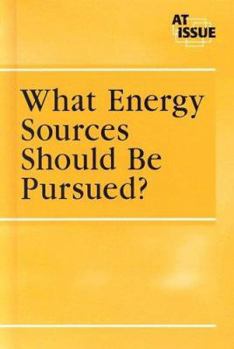What Energy Sources Should Be Pursued?
Select Format
Select Condition 
Book Overview
Modern society's utilization of fossil fuels has provided humanity with great benefits and many unintended consequences. What Energy Sources Should Be Pursued? examines the good and the bad inherent... This description may be from another edition of this product.
Format:Library Binding
Language:English
ISBN:0737727578
ISBN13:9780737727579
Release Date:October 2004
Publisher:Greenhaven Press
Length:112 Pages
Weight:0.69 lbs.
Dimensions:0.5" x 6.6" x 9.4"
Age Range:14 to 17 years
Grade Range:Grades 9 to 12
Customer Reviews
1 rating
Hydrogen Energy Web
Published by Thriftbooks.com User , 16 years ago
Hydrogen Solar technology uses sun light too create hydrogen. Tandem cell: Sunlight passes through two photo-catalytic cells in a series. The front cell absorbs the high energy ultraviolet and blue light in sunlight, using nano crystalline metal oxide thin films. The longer wavelength light in the green and red region is absorbed in the Graetzel Cell producing an electrical potential. The two cells are connected electrically and together provide the potential to split the water molecules in the electrolyte. The Tandem cell array produces hydrogen from sunlight and water and stored the hydrogen in a tank; the hydrogen is then used to produce electricity through the use of fuel cell stacks. Hydrogen from Bio Mass produces two products: pure water and hydrogen that can be used to produce electricity,. Hydrogen can also be produced from coal. Coal can be converted to methane and then reformed into hydrogen that can power a fuel cell stack to produce electricity. More advanced technologies like IGCC have the potential to create a syngas that can be reformed into hydrogen and then electricity. FuelCell Energy uses ultra clean DFC fuel cells and natural gas reform technology to produce 1.2 MW for Pepperidge Farms. In 2006, Fuelcell Energy was awarded $36.2 million to develop a coal-based, multi-megawatt solid oxide fuel cell-based hybrid system. The system will use Solid oxide fuel cell technology, a process to convert coal to coal gas, and a 50 percent efficiency to convert energy contained in coal to grid electrical power. FuelCell may consider submitting the project too FutureGen. Another company, Siemens Power Generation is building a highly efficient fuel cell hybrid power plant that will product megawatts class power plant. The goal of the research project is to get a 70 percent of fuel energy to electricity conversion percentage. The system will be a hybrid high temperature SOFC system. "In solid oxide fuel cells (SOFC), an electrochemical reaction converts fuel energy directly and very efficiently into electricity and heat." In 2007, FuelCell Energy sold a 5.1 MW system (DFC 1500MA) to South Korea and partners with POSCO Power. The system meets strict greenhouse gas reduction targets. FuelCell Energy says, "Supplying our fuel cell products to Korea's top utility companies is a clear demonstration of how utilities around the world can employ our ultra-clean fuel cell power to economically generate baseload power while helping support greenhouse gas reduction goals." The Connecticut Clean Energy Fund (CCEF) has 11 renewable energy projects to produce 100 MW of renewable energy: 7.9 MW FuelCell Energy and Enbridge system, 29.9 MW landfill gas project by EMCOR, 19.6 MW fuel cell project by Elemental Power Group. Why generate electricity twice, first, the electricity for electrolysis and then electricity by fuel cell? Hydrogen provides a way to store energy from renewable sources of energy. Nanoptek Corporation will p





